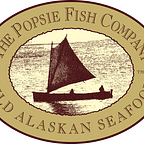What’s so special about sockeye salmon?
Sockeye salmon are Olympic athletes
Wild sockeye salmon are Olympic-medalist strong and shimmeringly healthy — before they ever reach your plate! After all, they compete all their lives. Consider that they begin life in a little stream somewhere in the wilds of Alaska, Canada or the Pacific Northwest, navigate all the way to the ocean, then swim a thousand miles or more to reach their feeding grounds! As these healthy, lithe athletes dart and weave to evade predators, they gobble up protein-rich crustaceans and plankton to prepare for their grueling journey back home. Through exquisite management by ADF&G, NOAA Fisheries and others, millions of healthy, robust sockeye salmon swim upstream on their destined journey to complete their life cycle and ensure future runs. Those sockeye that are caught in Bristol Bay, by setnetters, for your plate — those fish are the healthiest champions of their species! They are super stars — the gold medal winners who nobly provide you with the healthiest food you can eat.
Sockeye salmon are health rock stars
Wild sockeye salmon have lived their lives freely (and joyfully, we like to imagine), eating what nature intended them to eat: crustaceans, plankton, little fish. Consequently, they are loaded with nutrients. Famous for being one of the healthiest protein sources you can eat, they also pack a punch with their high Vitamin A and Covid-fighting Vitamin D-3 content. And you’ve probably heard about their long-chain polyunsaturated omega-3 fats? Those are exactly the healthy kind of fats that our bodies need, and salmon provide them in the form our bodies can easily use. Those essential fatty acids help prevent heart attacks and strokes. They can ease the pain of rheumatoid arthritis. They can even lower your chances of getting some types of cancer — or Alzheimer’s. Your health will rock on a diet blessed frequently with wild sockeye salmon.
Salmon are a chef’s delight
Sockeye salmon are just so versatile! Whether you’re the weekend barbecue chef, the meticulous hostess of a festive dinner party or the teenager who has Friday night meal duty, you can whomp up a sockeye salmon meal effortlessly — and it’s bound to delight the crowd. These quick-cooking fish can be thrown in a seasoned fry pan with some onions and lemon, grilled on a cedar plank and sprinkled with herbs, broiled quickly in the oven, or mingled with potatoes in a crockpot for a great chowder. Quick, attractive, tasty, healthy — just what the doctor (and everyone in the room) ordered!
Sockeye salmon can be found . . . in the trees
Relative to how many there are, salmon disproportionately and vigorously affect their ecosystem. In fact, they are a keystone species: if they were to disappear, that would grossly disrupt most all other living things in their world. But happily, sockeye salmon are thriving, and they are leaving a happy trail behind! Rotting salmon carcasses — the end result of their long, migratory journey — transfer valuable nutrients from the ocean to the land. Scientists have traced nutrients from salmon bodies and found them, not surprisingly, in bears, wolves and seagulls. But fish nutrients have also been found in mosses, herbs, shrubs and trees! They’ve even been found in insects and song birds. (We swear we’ve heard them singing joyful tunes of thanks to their fertile fish friends!)
Sockeye salmon are intense
Sockeye salmon are smaller and more compact than other varieties, which makes their flesh more firm. It stands up well to grilling and roasting. Sockeye have a more intense flavor than other salmon, and are known for their unique reddish-orange color. They invite the use of simpler recipes, because their own flavor is so distinct and delicious on its own. You don’t want to overwhelm these select fish with sauces or spices, but instead, season them lightly so you can enjoy their unique flavor.
Sockeye salmon runs are intense, too! The Bristol Bay watershed in Alaska supports the largest sockeye salmon fishery in the world, supplying almost half of the world’s abundance. The average annual in-shore run of sockeye salmon is an incredible 40 million fish. But in 2021? It topped 60 million! Ask the fishermen and women how intense that was!
Sockeye salmon enjoy polysyllabic nomenclature
Oncorhynchus nerka are anadromous (not to be confused with catadromous or amphidromous). They eat pelagic invertebrates including zooplankton, Pandaluseous, and Euphausiacea. Ichthyologists may study physiological phenotypes, fish homeostasis and smoltification. Many of us are gastronomic connoisseurs, but Pescatarians, in particular, enjoy most Salmonidae, finding them gustatorially pleasurable. (OK — we’ll stop there!)
Sockeye Salmon are special
We, like many others, celebrate all salmon! There’s Salmonfest, Salmon Run, Salmon Days — and many Salmon Festivals. There are dozens of Salmon Facebook pages — even a Salmon Poetry page. There are beautiful Salmon Art prints for sale. There’s a Salmon Dance, a Happy Salmon Card Game and even a fun Pacific Salmon Song so you can learn all five salmon varieties with a catchy tune.
But Sockeye Salmon — for taste, nutrition, stamina, prestige, distinction, status, prominence, cachet and outrageous great taste — sockeye salmon is simply the best!
